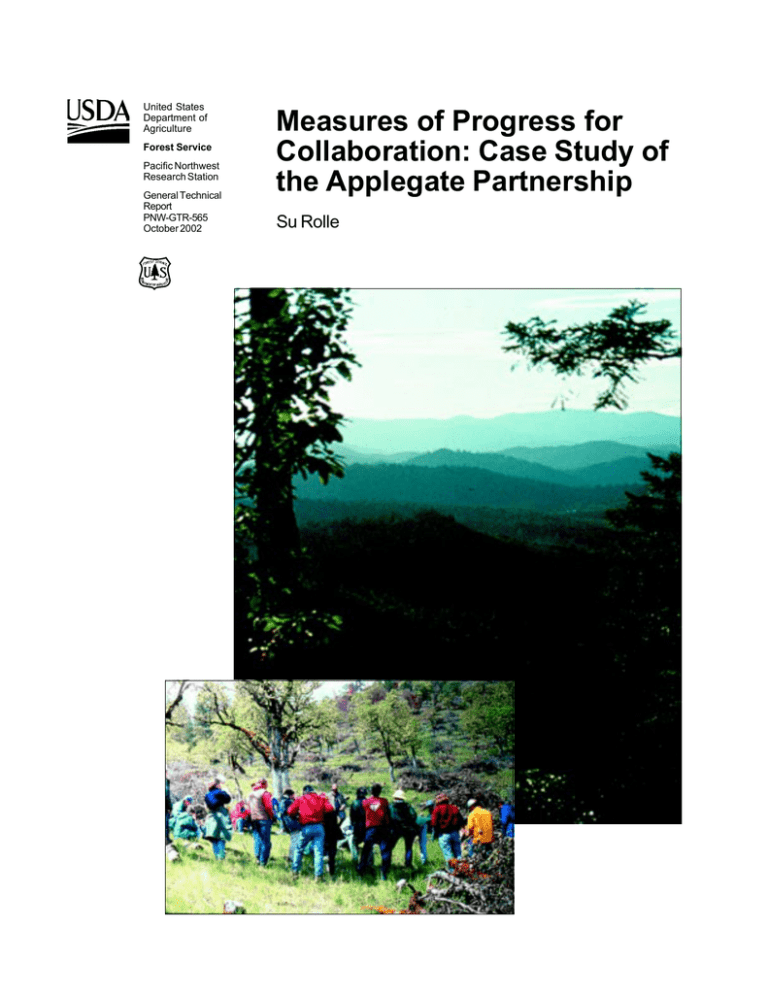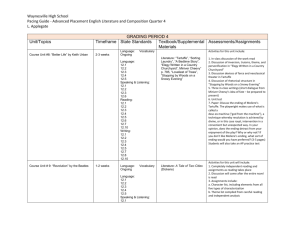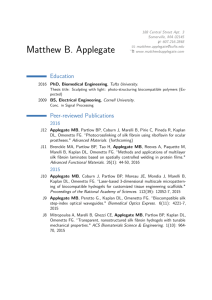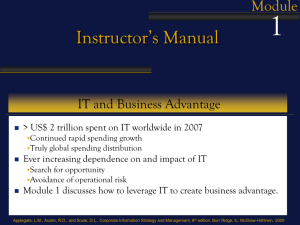Measures of Progress for Collaboration: Case Study of the Applegate Partnership
advertisement

United States Department of Agriculture Forest Service Pacific Northwest Research Station General Technical Report PNW-GTR-565 October 2002 Measures of Progress for Collaboration: Case Study of the Applegate Partnership Su Rolle Author Su Rolle is a consultant, Ashland, OR. The research for this paper was partially funded by the USDA Forest Service, Pacific Northwest Research Station. Abstract Rolle, Su. 2002. Measures of progress for collaboration: case study of the Applegate Partnership. Gen. Tech. Rep. PNW-GTR-565. Portland, OR: U.S. Department of Agriculture, Forest Service, Pacific Northwest Research Station. 13 p. Using the Applegate Partnership as a case study, this paper proposes a number of ways to measure the success of collaborative groups. These measures allow for providing evaluation and feedback, engaging needed participants, and responding to groups critical of the collaborative process. Arguing for the concept of progress in place of success, this paper points out that success is relative and should not be measured in absolute terms; tracking progress gives the sense of movement toward a goal or desired situation. Keywords: Natural resources, collaboration, monitoring for success, progress, partnerships. This page has been left blank intentionally. Document continues on next page. Introduction This paper was adapted from a presentation I gave in Bellingham, Washington, at the eigth international symposium on society and resource management on June 19, 2000. Collaborative efforts are creating new approaches for addressing social and natural resource conflicts. Decades of struggle have been followed by nearly a decade of peacemaking attempts by groups such as the Applegate Partnership. To what extent have these groups been successful at resolving issues? Has there been progress? What measures can we use to evaluate such efforts? The purpose of this discussion is to offer measures of progress for collaboration. Identification of measures is important in order for a group to clarify goals and strategic actions, use periodic benchmarks to assess effectiveness, and increase accountability and credibility. Suggested measures described herein have been developed over years of working with various collaborative efforts, especially the Applegate Partnership. The Applegate Partnership is used as a case study to apply these measures. Factors needed for collaboration have been well documented (Bergstrom et al. 1996, Borrini-Feyerabend 2000, Mattessich et al. 2001, Shannon et al. 1996, Whaley 1993, Winer and Ray 1994). These factors are valuable to groups in the initial stages of collaboration. Once established, a collaborative group needs to reflect so as to evaluate if progress is being made. And although some of the factors needed in the beginning of an effort could, in fact, be used in monitoring progress, additional measures also are needed. It has been argued that the term success should not be applied to collaborative efforts. Success is set up against failure; the concept is too “black and white.” Collaboration often moves through a series of successes and failures. Progress is a preferred term, and the measures are better framed in reference to movement from one situation toward the desired situation (Daniels 2000). People need to measure change. Individuals, groups, and organizations involved in collaborative efforts need to see progress; they need to see that something is being accomplished and that their efforts are worthwhile. Measures can identify what is working, what is not working, and focus efforts in areas of needed change. Additionally, there is the need to show results to the skeptics of such efforts. Measures can give credibility and accountability to the collaboration. Measures of Progress Measures of progress for collaboration include the ability of a collaborative group to: · Meet its mission and achieve outcomes. · Be sustained. · Understand the community. · Be inclusive and diverse, reflect the community. · Create a forum for diverse ideas and shared learning. · Increase community capacity. · Increase cooperation across organizational, administrative, and jurisdictional boundaries. · Stimulate innovation, new ways of doing business. · Facilitate changes in policy, laws, and programs. 1 Applying Progress Measures to the Applegate Partnership Background A brief description of the setting may be helpful before applying these measures to the Applegate Partnership. The Applegate Watershed, located in the Siskiyou Mountains of southwestern Oregon, is approximately 500,000 acres with about 12,000 residents. Nearly two-thirds of the residents live adjacent to Grants Pass, and the remaining live in unincorporated towns and rural areas similar to other rural timber-dependent communities in transition. There is a larger constituency of environmental activists with a longer history than in most rural areas in the Northwest; many local and regional groups originating over 25 years ago are still active today. Seventy percent of the watershed is federally managed by the USDA Forest Service and USDI Bureau of Land Management; the remaining 30 percent is primarily in private ownership. Accelerated clearcutting and road building following World War II impacted the land and public attitudes. By the early 1990s, the lawsuits and subsequent injunctions due to the listing of the northern spotted owl had virtually shut down logging on federal lands in southern Oregon. Increased fire hazard had become, and continues to be, a great concern to most residents. Until the mid-1990s, the two agencies managing lands in the watershed were highly autonomous. Coordination occurring among local and federal agencies and residents was legally sufficient but lacked optimal cooperation. The Applegate Partnership was formed in October 1992 with the vision (or mission) that still serves today: The Applegate Partnership is a community-based project involving industry, conservation groups, natural resource agencies, and residents cooperating to encourage and facilitate the use of natural resource principles that promote ecosystem health and diversity. Through community involvement and education, this partnership supports management of all land within the watershed in a manner that sustains natural resources and that will, in turn, contribute to economic and community well-being within the Applegate Valley (Applegate Partnership 1993). The Applegate Partnership embraced strong and common values held by many residents, local environmentalists, industry, and agency personnel. The vision and goals addressed critical issues of land management (Applegate Partnership 1993). The early years were highly challenging in terms of resolving conflicts, developing trust, creating a “level playing field,” making decisions, agreeing on specifics (objectives and projects), and maintaining diversity of participants. Several authors have described many of the processes, complexities, and specific paradoxes of the formative years of the Applegate Partnership (KenCairn 1996, Lange 1997, Sturtevant and Lange 1995). It was also an exciting, exhilarating period. Participants knew they were breaking new ground; there was no template for bringing together the diverse individuals, groups, and organizations involved. As relationships developed between former adversaries, there was an emerging sense of hope. Participants began to see benefits of networking to address problems beyond those of the Applegate Watershed. The Applegate Partnership continues to be an influential collaboration today. But critics from within and outside of the partnership can still be heard saying, “Nothing has happened!” Using measures of progress can lead to more productive critique. Meet Its Mission and Achieve Outcomes 2 For any group to evaluate its effectiveness, an obvious check is, “How well does it meet its own mission? Did it achieve the desired outcomes?” Or in terms of progress, has there been appreciable movement toward meeting the desired results? The Applegate Partnership has achieved significant changes in conditions in the Applegate Watershed. Goals outlined in the Applegate Partnership vision and brochure (Applegate Partnership 1993) have either been met or appreciable progress toward these goals can be tracked. For instance, the increased cooperation between industry, conservation groups, agencies, and residents is significant. In less than a decade, relations have improved from a state of extreme polarity to one of respect and cautious hope. The cooperation is described more fully as a separate measure below. The Applegate Partnership has achieved a community-based project. The Applegator newspaper was created by the partnership and is distributed free to all residents and landowners in the Applegate Watershed. For the first several years, the newspaper featured articles on such topics as streams, fish, fire danger, local businesses, and neighborhoods along with a map of the entire watershed depicting some aspect of the area. This repeated map feature was effective in helping people to identify with the area. People began to have a “watershed identity” and understand that “this is our home and we’re all in it together.” Although difficult to measure, ecosystem health and diversity have significantly improved. There has been a profound shift from clearcutting to selective cutting on all federal agency lands in the Applegate Watershed, and the shift was accelerated by the partnership’s involvement. The encouragement to focus primarily on what should be left in the forest rather than what could be taken resulted from numerous field trips with residents. There has been a dramatic change in the average diameter of trees cut— from the larger (greater than 22 inches in diameter at breast height) to smaller trees (often 8 to 12 inches in diameter at breast height) (see fig. 1). For example, from thinning data gathered in the Applegate Adaptive Management Area on trees cut since Figure 1—Thinning smaller diameter trees leaves older and larger trees in the forest than in years past. Photo by Steve Armitage 3 1995, 84 percent were 8 to16 inches diameter, 11 percent were 18 to 22 inches, and less than 5 percent were greater than 22 inches in diameter (Armitage 2002). Project timber sales were replaced by integrated watershed analysis and landscapelevel plans identifying all needed projects across the watershed. Integrated planning was done on both private and federal lands. (This landscape-level planning preceded the Northwest Forest Plan and direction for watershed analysis). And the processes of planning by federal agencies were made much more accessible and responsive to the public. Although many of these changes may have occurred without the Applegate Partnership, the collaboration greatly accelerated the changes. The “crown jewel” and working arm of the Applegate Partnership is the Applegate River Watershed Council. The council is a subcommittee of the Applegate Partnership that focuses on improving watershed conditions. It has achieved far-reaching success in the community with concrete results such as tree planting, riparian fencing, removal of fish barriers, ditches, etc. (see fig. 2). The council has completed extensive watershed analyses and complex planning across private lands in cooperation with local and federal agencies. Council staff approach residents (as potential partners in watershed restoration) with a high level of sensitivity, respecting the landowners’ rights, and seeking common values. The Applegate River Watershed Council also has taken on functions historically completed by other government entities such as developing plans and suggesting regulations for gravel extraction along creeks and rivers (see fig. 3).1 The council has consistently facilitated cooperation across various jurisdictions to restore and monitor lands and streams. This has been done by vigorous, consistent contacts with all the principle agencies and through interagency meetings hosted by the council. The council’s work has resulted in miles of improved habitat along the river and tributary creeks since 1992. Education and outreach is an important goal of the Applegate Partnership. The changes in the last 8 years in public knowledge have been profound. The partnership and agencies have sponsored numerous workshops, field trips, and open forums that are well attended. The Applegator newspaper continues to serve as an important source of information. The Applegate Partnership has inspired many individuals and groups to become involved in project planning. All local, state, and federal agencies have seen a significant increase in community interest and participation in the Applegate Watershed since 1992 directly as a result of the partnership’s outreach efforts. Be Sustained It is imperative that the collaborative effort be sustained in order to accomplish its goals. A structured collaborative group could be seen as the necessary embryonic stage before needed systems changes can be implemented (Hogue 2000). If the ultimate goal is long-term system changes, then persistence of the structured collaborative effort may not necessarily be an appropriate measure. Ideally, a collaborative group will identify specific outcomes, policies, and laws needed to accomplish the vision. Recognizing that there will always be a need for people to collaborate—to work together and share ideas—it seems possible that collaboration could, in fact, be built into how we “do business.” For some groups, once the mission is accomplished, the group is no longer needed and could be “sun-downed” with appropriate celebration. 1 The council received an award from the State of Oregon Department of Geology for progressive work and proposed regulations that can be applied throughout the state. 4 Figure 2—Applegate Watershed Council crews work to install a “fish-friendly” intake pipe for irrigation on private land. Photo by Jan Perttu Figure 3—Past sand and gravel extraction has degraded fisheries in many locations. Industry, environmentalists, and affected residents worked with the Applegate Watershed Council to develop regulations designed to protect and create habitat for fish. Photo by Jan Perttu 5 Since 1992, the Applegate Partnership has been sustained—a remarkable accomplishment given that most of those years the group met a minimum of once a week. It often takes a champion, one individual committed to making something work (Whaley 1993). In the case of the Applegate Partnership, many energetic visionaries—Jack Shipley being the most active—have been critical to its sustenance. The partnership discussed a “sun-down” provision at its inception. No official date was set, but it was agreed that if the group deemed it were no longer necessary or no longer effective, then it would disband. Understand the Community Successful collaborative efforts will result in the group having a better understanding of the community—the people, cultures, values, and habits. Depending on the scope of the effort, this also can mean understanding neighborhoods as well as the formal and informal networks. Community understanding can contribute to a more strategic vision and in more effective solutions that are supported. Although the partnership was focused on natural resources from the beginning, there was great appreciation of the importance of understanding the community. The group initiated a community assessment before launching the many ecological assessments (Preister 1994). The assessment has been useful for the partnership, serving to focus the group on key sectors, values, problem areas, and neighborhoods. Also, there has been an increase in understanding the community through educational forums, fairs, and diverse articles in the Applegator (see fig. 4). The newspaper prints various viewpoints. Feature articles are as varied as “Way Back When” (history), “Behind the Green Door” (environmental perspective), “Timberline” (timber industry), and opinion pieces. Be Inclusive and Diverse, Reflect the Community Most collaborative efforts have found that the “right mix” of people and groups is essential to make progress. This may involve interest groups, end users (people affected by decisions or changes), and anyone who could later block a decision. Figure 4—A committee works to review the Applegator, a newspaper published by the Applegate Partnership and mailed to all households in the watershed. Photo by Jan Perttu 6 Sectors of the community also must be reflected in the mix of collaborators for a better understanding of problems and issues, creativity in the solutions, and long-term commitment to decisions. This measure is closely intertwined with the previous measure, “Understand the Community.” The Applegate Partnership strives to be as open and inclusive as possible. Strong efforts to widely advertise meetings, and holding meetings in central areas in both indoor and field settings are examples of attempts to attract a diverse group. For the first several years, the partnership benefited from participation of many sectors. Over time, however, several key board members have moved, leaving leadership gaps. Participants have made special outreach efforts to underrepresented sectors such as ranchers, small timber operators, national environmental groups, scientists, and academicians. Strong facilitation created a climate for inclusiveness and enabled expression of diverse viewpoints in the first several years. This was a significant factor in the viability of the partnership and valuable as the skilled facilitators offered their services for free. Two key facilitators slowly withdrew over time, as participants seemed to increase in their ability to facilitate themselves. However, the lack of effective consistent facilitation has resulted in less participation by members of timber and agency communities. A particular challenge to the partnership has been the inclusion of individuals and groups holding strong “no-management” values. The dilemma is that although this “hands-off” value is held by a small percentage of residents, it is not aligned with the vision and goals of the Applegate Partnership. Much time and energy has been devoted to listening, trying to understand, and seeking common ground. Clearly, there has been an increase in understanding from the years of interaction but little resolution. More formal mediation may be useful during critical meetings. It also has been argued that, in order to have productive meetings, participants need to “buy in” to the basic mission of the group. Other venues for discussion outside of meetings could be created to allow airing of values and ideas not consistent with the group’s mission. Create a Forum for Diverse Ideas and Shared Learning Although diverse individuals and groups can be brought together, it is challenging to create a forum in which diverse ideas are expressed respectfully, trust is developed, and shared learning occurs. Learning can result from either success or failure, from things that work as expected or things that do not work (Stankey and Shindler 1996). The Applegate Partnership has created an open educational forum. One person recently said, “I’ve learned more from these partnership meetings than I ever could have from a library.” By encouraging field trips, slide shows, presentations, and open dialogue, participants have been exposed to a significant amount of social and scientific information (see fig. 5). The opportunity to engage scientists and others working in communities, agencies, and research organizations has provided a rich mixing of knowledge. As mentioned, the Applegator also serves as a neutral forum for sharing information, local history, and diverse ideas. The knowledge and understanding gained by agency personnel from local residents merits attention. The traditional pride of professionalism has, in many cases, been balanced with a genuine respect and appreciation for local knowledge. There has been a change in how local managers see the community and the land, and especially how they describe what is desired for the future. An increase in willingness to take risks among many agency personnel is a profound shift from tradition. One participant 7 Figure 5—An increase in communication between residents and agency personnel has created a better understanding of ecosystem principles by residents and of indigenous knowledge, history, and values by the scientists and managers. Photo by Tom Sensenig described the overall changes she perceived among many agency personnel by saying, “They’ve become much more humble and open to ideas. I see lots more communication than before the partnership.” Changed attitudes are reflected in many planning documents and projects. Increase Community Capacity Community capacity could be defined as the ability of a community to be resilient to the inevitable changes that may occur, e.g., economic, ecological, and social crises, by taking actions to survive and thrive. For instance, following a mill closure, some communities have atrophied, taken a passive approach hoping for assistance. Others were proactive; they organized to adapt to the changes and created new opportunities. If a collaborative effort results in the community being mobilized to tackle important issues and take action, then the effort could be deemed successful. Snow has offered the term, community conservation, for the emerging natural resource collaborative efforts and suggests three implications (Snow 1996): · Deep involvement of local community in conservation and care of nearby natural resources, for the benefit of people and nature together. · Conservation of the community itself—of attitudes, processes, duties, responsibilities, and relations needed to form and maintain healthy relations. · Sense of community that is broader than local (national and international). Effective collaborative groups result in an increase in leadership, facilitation, and communication skills among participants. Additionally, there are increases in links among individuals, groups, and organizations as a result of effective collaboration. This sense of connectedness results in new patterns of communication—both in formal and in informal networks (Bergstrom et al. 1996). This, in turn, increases a community’s 8 capacity to address and solve other problems. Effective collaboration results in creativity and innovation. The Applegate Partnership has “inspired and empowered community members and organizations to take action and address emerging social, natural resource, and economic issues” (Sturtevant 1998: 52). There has been a proliferation of community forums for civic action regarding local economic development and reinvestment, land use zoning, watershed restoration, and stewardship of public resources and facilities. Some of these have their origins in partnership meetings or task groups. Individuals involved in the partnership formed many other groups by networking with other interested residents. Increase Cooperation Across Organizational, Administrative, and Jurisdictional Boundaries If progress can be made in increasing the cooperation across organizational, administrative, and jurisdictional boundaries, the potential for a collaborative group to achieve its goals is greatly enhanced (Shannon et al. 1996). In fact, the effects of increased cooperation across these sectors will likely have benefits beyond the focus of individual collaborative groups. There are many examples of increased cooperation and subsequent results since the inception of the Applegate Partnership. For instance, one of the first things the group requested from the agencies was a good geographic information system (GIS) map of the entire watershed (see fig. 6). It became obvious in 1992 that this kind of information was held by individual agencies but not shared across agencies. The subsequent merging of multiple GIS databases from federal, state, county, and private lands has Applegate Watershed Figure 6—Developing the extensive geographical information system database for the Applegate Watershed was an example of outstanding collaboration between multiple agencies, institutions, and private individuals and companies. 9 resulted in a comprehensive GIS for the ½-million acre area. It is shared as a common database through publicly accessible computer centers in the Applegate Watershed. The Applegate River Watershed Council and other private landowners have greatly benefited from this cooperation in planning and enhancing their ability to secure grants and implement projects. The Applegate Partnership also has accelerated day-to-day cooperation and sharing of resources across various administrative units responsible for lands in the Applegate Watershed. There has been a significant increase in the cooperation among Bureau of Land Management, Forest Service, U.S. Fish and Wildlife, U.S. National Marine Fisheries, and other federal, state, and local agencies. Some increase would have occurred anyway as a result of the planning and policy changes in the Northwest. Bur participants agree that much interaction is the direct result of the Applegate Partnership and the Applegate River Watershed Council’s facilitation and challenging proposals. The current work of the council to test a project merging the Clean Water Act and the Endangered Species Act brings together over 10 local and federal agencies. Stimulate Innovation, New Ways of Doing Business Another measure of progress for collaborative efforts is the innovation in ways individuals, organizations, and agencies do business. This is often the precursor to changes in policies, programs, or laws. Innovative changes can be informal, such as networking, or more formalized, as in creating new social or organizational bridges or structures. The willingness of individuals in collaboration to try new behaviors, stretch beyond traditional roles, focus on problems in new ways, and learn together are key characteristics of successful collaborative efforts (Wondolleck and Yaffe 2000). The Applegate Partnership created a forum that was entirely new in the way individuals, groups, and agencies communicated and worked together. The “playing field” was “leveled” in an entirely different configuration with environmentalists, industry representatives, farmers and ranchers, and agency personnel sitting at the same table and looking at a common problem. Facilitators helped the group reframe the issues and problems. Agencies were no longer at the “center” trying to negotiate solutions that met everyone’s needs. The problem or issue was at the center, and the creativity in viewing the problem and identifying solutions was greatly enhanced. Examples of new approaches by the land-managing agencies as a result of working with the Applegate Partnership include: 10 · Establishing planning teams in which residents are active participants along with agency personnel. · Sponsoring local educational forums as well as many more field trips for projects. · Working with the Applegate River Watershed Council in identifying restoration projects across the entire watershed (including sharing of GIS database). · Exploring new budget methods to fund acres treated rather than traditional targets (e.g., timber sold). · Creating a core team of key people from several agencies to focus on the Applegate Watershed and share resources. · Establishing an interagency liaison position to increase cooperation among agencies and communities. · Creating an awareness and an expectation among the residents and the local, state, and federal agencies that “everyone needs to be at the table” to tackle the problems and create solutions. An example of innovation by the Applegate community is the management of Cantrall Buckley Park. This county park was slated for closure owing to shortage of funds in the mid-1990s. The Applegate Partnership recognized its value to the community and facilitated a coalition of numerous service organizations to manage the park rather than the county managing the park. This “people’s park” is in its fifth year of coalition management and is serving the community well. Weekend outdoor movies and nature trails are among the many improvements. There are many examples of innovative approaches initiated by the Applegate Watershed Council. For example, the council has facilitated neighbors working together to reduce fire danger across neighborhoods and assisted them in securing grants to accomplish the work (see fig. 7). As mentioned before, the council has organized watershed restoration by neighborhoods. Facilitate Changes in Policy, Laws, and Programs A critical measure of progress for collaboration is its effect on policy, law, regulation, or program. This may be a key outcome for collaboration—Can desired changes be institutionalized? The Applegate Partnership has influenced certain programmatic changes described earlier such as the shift from clearcutting to selective cutting, shift from cutting largediameter to small-diameter trees, development of a small-diameter materials program, increase in attention to fire risk to private lands, increase in the number and mix of people on field trips, and creation of new advisory committees to counties. Many people believe the partnership had an important role in encouraging a new type of land use planning zone under the Northwest Forest Plan (USDA and USDI 1994). The adaptive management areas were designed to offer new approaches to land management, specifically to emphasize adaptive management practices, including settings where “new connections among interests—community, science, management—could be explored” (Stankey and Clark 1998). Figure 7—Marty Main works with residents to form stewardship plans for entire neighborhoods. Photo by Jan Perttu 11 Progressive regulations for aggregate mining in Josephine County were implemented as a direct result of the Applegate River Watershed Council. This was the first time such regulations incorporated extensive information about fisheries as well as meeting needs of local residents. However, there is still disappointment about the many policy and program changes that have not yet been implemented. Certainly facilitating the needed institutional changes is some of the toughest collaborative work possible. The Applegate Partnership has, over the years, given priority to certain tasks intended to create policy changes by developing subcommittees to accomplish them. It may again be time for the partnership to identify key policy or law changes that are needed and work vigorously toward those goals. Conclusion Clear evaluation criteria and frequent feedback loops have been a mainstay in effective organizations for years. Likewise, collaborative groups also can benefit from measures of progress. Although examples in this discussion are from a collaboration focusing on natural resources, these measures of progress also could be applied to other types of collaborative efforts. Ideally, measures of progress also would include measurable indicators depending on the group and mission. In many cases, including the Applegate Partnership, a shared vision is created before measures of progress are developed. This can lead to inconsistencies between the vision and actual desired outcomes (Bergstrom et al. 1996). Although early description of measures and indicators is ideal, a collaborative group will benefit from defining measures of progress at any time in its evolution. The use of measures offers a collaborative group the ability to track progress, engage needed participants, and thwart unwarranted criticism. References Applegate Partnership. 1993. Applegate Partnership [Brochure]. Grants Pass, OR. 28 p. Armitage, S. 2002. Unpublished data. On file with: USDI Bureau of Land Management, Ashland Resource Area, 3040 Biddle Rd., Medford, OR 97504. Bergstrom, A.; Clark, R.; Hogue, T. [et al.]. 1996. Collaboration framework— addressing community capacity. Fargo, ND: National Network for Collaboration. 18 p. http://crs.uvm.edu/nnco. (10 March 2002). Borrini-Feyerabend, G. 2000. Collaborative management of protected areas: tailoring the approach to the context. IUCN, The World Conservation Union, Social Policy Group. http://www.iucn.org/themes/spg/Tailor. (12 April). Daniels, S. 2000. Personal communication. Director, Western Rural Development Center, Utah State University, 8335 Old Main Hill, Logan, UT 84322-8335. Hogue, T. 2000. Personal communication. Director of the Chandler Center for Community Leadership, 2600 NW College Way, Bend, OR 97701. KenCairn, B. 1996. Peril on common ground: the Applegate experiment. In: Brick, P.D.; MacGreggor Cawley, R., eds. A wolf in the garden: the land rights movement and the new environmental debate. London: Rowman and Littlefield Publishers, Inc. 304 p. 12 Lange, J.I. 1997. Exploring paradox in environmental collaborations. In: Brick, P.D.; Snow, D.; Van de Wetering, P. Across the great divide: explorations in conservation and the American West, 2000. Washington, DC: Island Press: 200-210. Mattessich, P.; Muray-Close, M.; Monsey, B. 2001. Collaboration: What makes it work? 2nd ed. Saint Paul, MN: Amherst H. Wilder Foundation. 104 p. Priester, K. 1994. Words into action: a community assessment of the Applegate Valley. Ashland, OR: Rogue Institute for Ecology and Economy. 132 p. Shannon, M.; Sturtevant, V.; Trask, D. 1996. Organizing for innovation: a look at the agencies and organizations responsible for adaptive management areas—the case of the Applegate Adaptive Management Area. Medford, OR: U.S. Department of the Interior, Bureau of Land Management; U.S. Department of Agriculture, Forest Service. 29 p. Snow, D. 1996. Coming home: chronicle of community. Missoula, MT: Northern Lights Institute. 1(1): 40-43. Stankey, G.H.; Clark, R.N. 1998. Adaptive management areas: roles and opportunities for PNW Research Station. Unpublished document. 10 p. On file with: George Stankey, USDA Forest Service, Pacific Northwest Research Station, 3200 SW Jefferson Way, Corvallis, OR 97331. Stankey, G.; Shindler, B. 1996. Adaptive management areas: achieving the promise, avoiding the peril. Gen. Tech. Rep. PNW-GTR-394. Portland, OR: U.S. Department of Agriculture, Forest Service, Pacific Northwest Research Station. 21 p. Sturtevant, V. 1998. Applegate partnership, Applegate Adaptive Management Area guide. Medford, OR: U.S. Department of the Interior, Bureau of Land Management; U.S. Department of Agriculture, Forest Service. 145 p. Sturtevant, V.; Lange, J. 1995. Applegate partnership case study: group dynamics and community context. Ashland, OR: Southern Oregon State College. 102 p. U.S. Department of Agriculture, Forest Service; U.S. Department of the Interior, Bureau of Land Management. 1994. Record of decision for amendments to Forest Service and Bureau of Land Management planning documents within the range of the northern spotted owl. Portland, OR. 74 p. [plus attachment A: standards and guidelines]. Whaley, R.S. 1993. Working partnerships: elements for success. Journal of Forestry. 3: 10-11. Winer, M.; Ray, K. 1994. Collaboration handbook: creating, sustaining, and enjoying the journey. Saint Paul, MN: Amherst H. Wilder Foundation. 192 p. Wondolleck, J.M.; Yaffe, S.L. 2000. Making collaboration work, lessons from innovation in natural resource management. Washington, DC: Island Press. 277 p. 13 This page has been left blank intentionally. Document continues on next page. The Forest Service of the U.S. Department of Agriculture is dedicated to the principle of multiple use management of the Nation’s forest resources for sustained yields of wood, water, forage, wildlife, and recreation. Through forestry research, cooperation with the States and private forest owners, and management of the National Forests and National Grasslands, it strives—as directed by Congress—to provide increasingly greater service to a growing Nation. The U.S. Department of Agriculture (USDA) prohibits discrimination in all its programs and activities on the basis of race, color, national origin, gender, religion, age, disability, political beliefs, sexual orientation, or marital or family status. (Not all prohibited bases apply to all programs.) Persons with disabilities who require alternative means for communication of program information (Braille, large print, audiotape, etc.) should contact USDA’s TARGET Center at (202) 720-2600 (voice and TDD). To file a complaint of discrimination, write USDA, Director, Office of Civil Rights, Room 326-W, Whitten Building, 14th and Independence Avenue, SW, Washington, DC 20250-9410 or call (202) 720-5964 (voice and TDD). USDA is an equal opportunity provider and employer. Pacific Northwest Research Station, 333 S.W. First Avenue, P.O. Box 3890, Portland, Oregon 97208-3890. Pacific Northwest Research Station Web site http://www.fs.fed.us/pnw Telephone (503) 808-2592 Publication requests (503) 808-2138 FAX (503) 808-2130 E-mail pnw_pnwpubs@fs.fed.us Mailing address Publications Distribution Pacific Northwest Research Station P.O. Box 3890 Portland, OR 97208-3890 U.S. Department of Agriculture Pacific Northwest Research Station 333 S.W. First Avenue P.O. Box 3890 Portland, OR 97208-3890 Official Business Penalty for Private Use, $300







